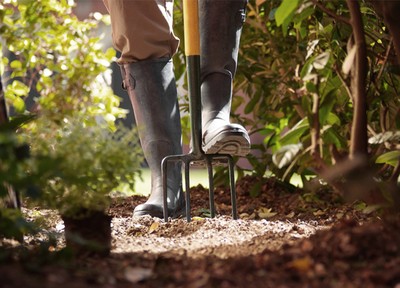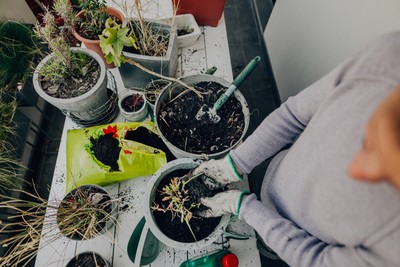
How To Get Into Gardening
How did you get into gardening, Toby?
My mother’s side of the family are uber-keen gardeners, so I’ve been in a garden for as long as I can remember. Some of my earliest memories are sowing seeds with my grandfather in his shed. Clearly the indoctrination from an early age worked because I went on to do a degree in horticulture followed by a PhD in garden history.
Have you noticed a surge in interest in gardening recently?
Absolutely. I think the succession of lockdowns has made those of us who have gardens refocus on just how important a part of our lives they are. While those who maybe didn’t do so much in their garden have discovered what an amazing resource they have just outside or on a balcony.
What do you think gardening can do for us?
I’ve always thought being in a garden and the physical activity of gardening, reconnecting with the soil, is so good for our wellbeing, both psychologically and physically – well, apart from the achy back. That’s even more the case right now. A garden brings pleasure as a calm place. It’s a retreat from the craziness of daily life, a place to decompress and revitalise – my mind certainly goes into a tranquil zone when I’m gardening. A garden is also a place where we can express our individual creativity, and that’s always fun.
What are the current trends in gardening?
Driven I think by the lockdowns and also prior concerns about the provenance of our food, there’s been a welcome boom in home-growing fruit and veg. The drive to garden for wildlife is really encouraging too.
If you want to improve or revamp your garden, what do you need to consider?
If you are making or revamping beds, the nutrient status and quality of the soil is key. Remove all the perennial weeds (dandelions, cooch grass, ground elder, thistles, bindweed etc) and all of their roots. You’ll also need to consider drainage, especially if your garden is on clay – it may be necessary to dig in some sand or grit. And plan ahead: if you think you might want to put lights or a water feature that requires a pump, install the electricity cables during the build rather than later, and be sure to follow all necessary regulations.
Would you recommend calling in a pro for bigger projects?
Unless you possess all the skills and tools, it’s a good idea to have a professional do the hard landscaping like paving, walls, fences, pools and rockeries. If you take this route, don’t panic if your garden-to-be looks like a battlefield for a while. Ground preparation is 90% of the work and makes a mess, but then it all comes together quickly at the end. To find a reputable contractor, the British Association of Landscape Industries has an accredited scheme.
What good sources of gardening inspiration are out there?
You mean apart from my excellent new book? Blatant plug aside, there are so many other great sources. Some of my favourite magazines are Gardens Illustrated, The English Garden and an American one, Garden Design. There are heaps of websites too, but Pinterest is a great source of visual ideas. With all of these, the first rule is to not be intimidated by the picture-perfect gardens featured. Use them as a source of ideas. When I’m designing a garden, I always tell my clients to spend some time thinking about what they want the garden to achieve for them, and to make a wishlist and a scrapbook of ideas they like. Then you can start prioritising.
Are there any particular plants we should be checking out right now?
There are a surprising number of shrubs and small trees that brighten up this gloomy time of year. One of my favourites is Chinese witch hazel, which has scented, yellow spider-like flowers born of the twigs – and you get a bonus of spectacular autumn leaf colour with this one. The evergreen Mahonia ‘Apollo’ also has scented yellow flowers. The white flowers of winter-flowering honeysuckle smell divine, as do those of wintersweet, which is great trained against a wall in a sunny, sheltered corner. Then there are bulbs: snowdrops, winter aconite and early daffodils such as ‘February Gold’, ‘Early Bride’ and 'Ice Follies’.
What can you be doing in this latest lockdown to prep a garden for 2021?
The winter is pretty much a downtime for gardening, but so long as the ground is neither frozen nor too wet to walk on (you don’t want to compact wet soil) it’s a good time to prepare beds. Remove perennial weeds if their leaves are still above ground and you can locate them; and add composts to beds. If you have a greenhouse, give it a good clearout and spring clean – Jeyes Fluid is a good cleaning agent. Otherwise, winter is a great time to plan for the coming season: look about for inspiration; maybe sketch out a plan of what you want to achieve in 2021; order the seeds and bare-root plants you are going to grow.
What are the other important times of year to pencil in for other basic gardening jobs?
Generally, it’s a good idea to keep a garden diary noting dates, what worked and what didn’t. I tend to start off with some plants grown from seed indoors in February – check the seed packets for specifics. I start dahlias in pots in early April, and am ready to cover the posts with a horticultural fleece to protect from frost if it threatens, then transplant the plants once the last frost is past. This way they get a head start and flower a bit earlier. Note the date when the last frost happens, after which it’s time to plant out bedding plants and tender annuals. I sow small successions of vegetable seeds throughout the summer to get a continual and not-too-large harvest – again, check the seed packet or online sources for specifics.
What are some straightforward ways to spruce up an outdoor space?
Plant up some pots and containers; sow an annual meadow; install a water feature; make a veggie garden using raised beds.
Any tricks for turning a small city garden into an urban oasis?
Think about exotic plants like palms, bamboo, banana and ferns. You can use mirrors to reflect light into a garden and make it look bigger. Installing lighting can help. A pergola smothered with climbers can provide some privacy from neighbours.
And if you’ve got a medium-sized garden?
All the above, plus: install a firepit (if regulations allow), add a water feature, and use a trellis to grow plants over – this can also help divide up the garden.

iStock/AleksandarNakic
What are the best ways to green up a balcony space?
Lots of containers, including those planted with herbs and veggies. There are some great dwarf varieties around now.
How easy is it to create a home allotment for fresh fruit and veg?
I like to use raised beds as it makes for easy organisation and looks nice. In the last few years I have become a convert to the ‘no dig’ technique for growing fruit and veg, and also when making new flowerbeds. You can Google for details, but in essence you can do this inside raised beds or where the bed is to be (even straight onto an existing lawn):
1. Remove perennial weeds by hand (no weedkiller).
2. Place flattened cardboard boxes (remove any tape) onto the area.
3. Cover with 15-20cm depth of good, well-rotted compost. (Horse manure is best if the horses are in stables on straw. Don’t use manure that has sawdust or wood chips in it). If you’re not using raised beds you may need temporary edges of planks until the compost has settled.
4. Let the compost settle for a week or so then plant into it.
5. Don’t dig the soil ever again, but just top up the compost annually.
This is so easy, labour saving, doesn’t hurt the back, requires less watering, and you get virtually no weeds. A big win on all scores.
How do you look after a lawn properly through the course of a year?
Sprinkle lawn-specific fertiliser at the appropriate rate (read the bag) over the lawn in early spring and again in early autumn. If it’s an established lawn, don’t worry if it goes brown in dry weather; if it’s newly sown or laid turf, you will have to water it the first season during dry times.
Have you got a magic formula for enjoying weeding?
There’s no magic formula, although I find it’s best done when in a bad mood – there’s nothing like executing the odd dandelion to make you feel better. That said, the non-dig technique I described above also minimises weed growth. How often you should weed depends on season and climate, but it’s always easiest and best to remove weeds when they are small seedlings rather than let them grow.
How do you approach watering?
Another advantage of the non-dig approach is that the layer of compost reduces evaporation. But never let plants get to a point when they are wilting – that shows they are already stressed. If this does happen, a good soak will usually revivify them. The best watering test is to stick a finger in the soil: if it feels moist, you are okay; if it’s only slightly damp, it’s time to water. Again, the overall frequency is weather-dependent.
Thanks a lot for your time, Toby. Any final words of advice for a rookie setting out to raise their gardening game this year?
Gardening is a never-ending learning experience, so don’t worry if you make mistakes or things go wrong. This happens every year to even the most expert gardeners. There’s always a next time with gardens and you learn from mistakes. That’s all part of the pleasure.
Gardening teaches us humility and patience. When we garden, in some ways we’re attempting to tame nature. That’s something, thankfully, we’re never going to totally achieve. Rather than fighting nature, work with it. For example, choose plants that like your soil conditions, climate and aspect rather than trying to grow those that don’t.
Lastly, garden organically and remember to use the four-year rotation system (Google it again) to ensure the right crops are grown together, and to minimise pest and disease problems.
Toby Musgrave is the author of The Garden: Elements and Styles, which was published recently by Phaidon. Find out more about the book here.
DISCLAIMER: We endeavour to always credit the correct original source of every image we use. If you think a credit may be incorrect, please contact us at [email protected].